
Welcome to sanbernardinosnakes.com! I am David, a snake enthusiast living in San Bernardino, CA. Many people don't know that San Bernardino is in fact full of snakes! You just need to know where to find them - they can often be shy and elusive. Some California snake species are more common outside of the city limits, in different parts of San Bernardino County CA, but many types of snakes are indeed common in the more urban parts of San Bernardino. This guide is meant to help educate you about the beautiful snakes of San Bernardino, and to help you identify the most common snakes of San Bernardino, as well as the venomous snakes of San Bernardino that you should learn to recognize and avoid. If you want more detail, click here for my complete list of ALL snake species in San Bernardino. Remember the following:
- Most snakes of San Bernardino are harmless and don't want to encounter you
- Venomous snakes exist but are uncommon in San Bernardino, California
- Snakes eat rats and mice and are a valuable part of the California ecosystem
- Never kill a snake - if you leave a snake alone, it will leave you alone.
Common Snake Species in San Bernardino
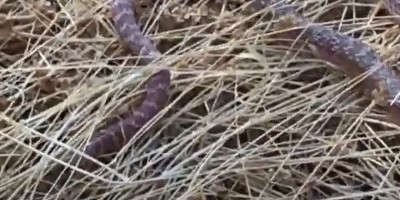 Red Racer:
Despite the name, the color of these non-venomous snakes can vary from red to brown. There is usually light banding or blotches as well. These speedy snakes can tolerate very high temperatures and thus are mostly active during the day. Three to five feet in length, they are the second-longest snake in California. As for prey, they are fond of mammals, including bats, but will also eat birds, reptiles, and carrion as well. As a result of their propensity to eat dead animals, they have an unfortunate tendency to end up as roadkill while going after the very same. Though not venomous, they will bite if aggravated, which is a common defensive mechanism amongst those of the racer and coachwhip snake species.
Red Racer:
Despite the name, the color of these non-venomous snakes can vary from red to brown. There is usually light banding or blotches as well. These speedy snakes can tolerate very high temperatures and thus are mostly active during the day. Three to five feet in length, they are the second-longest snake in California. As for prey, they are fond of mammals, including bats, but will also eat birds, reptiles, and carrion as well. As a result of their propensity to eat dead animals, they have an unfortunate tendency to end up as roadkill while going after the very same. Though not venomous, they will bite if aggravated, which is a common defensive mechanism amongst those of the racer and coachwhip snake species.
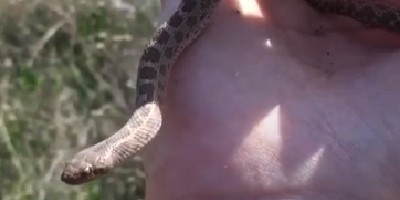 San Diego Night Snake:
One of several subspecies of night snakes found across California, this one can be observed across the San Bernardino area. Technically venomous, their toxicity is so low as to not be a concern for humans. Around a foot to two feet in length, they can be a variety of colors depending on the environment. Browns and blacks are common, however. As befitting their name, these snakes are nocturnal. They mostly eat lizards and their eggs, though they will eat amphibians as well. They have been known to wander into homes in search of food, which can happen with many snakes as they search for rodents and other small mammals to eat, as well as a warm place to nest.
San Diego Night Snake:
One of several subspecies of night snakes found across California, this one can be observed across the San Bernardino area. Technically venomous, their toxicity is so low as to not be a concern for humans. Around a foot to two feet in length, they can be a variety of colors depending on the environment. Browns and blacks are common, however. As befitting their name, these snakes are nocturnal. They mostly eat lizards and their eggs, though they will eat amphibians as well. They have been known to wander into homes in search of food, which can happen with many snakes as they search for rodents and other small mammals to eat, as well as a warm place to nest.
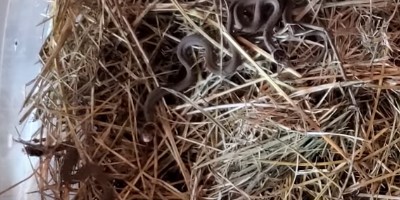 Desert Threadsnake:
If not for their black eyes, these snakes bear a striking resemblance to earthworms. Seven to sixteen inches in length, these tiny snakes feed on ants, termites, and their larva and pupae. Active burrowers and nocturnal by nature, they can be found above ground at night on occasion. Due to their diet, they live where the soil is moist and easy to tunnel through, though they will also freely move through ant and termite tunnels in search of food. Obviously, they are completely harmless to people, incapable of biting and posing anything more than a brief startle on the rare times they make an appearance.
Desert Threadsnake:
If not for their black eyes, these snakes bear a striking resemblance to earthworms. Seven to sixteen inches in length, these tiny snakes feed on ants, termites, and their larva and pupae. Active burrowers and nocturnal by nature, they can be found above ground at night on occasion. Due to their diet, they live where the soil is moist and easy to tunnel through, though they will also freely move through ant and termite tunnels in search of food. Obviously, they are completely harmless to people, incapable of biting and posing anything more than a brief startle on the rare times they make an appearance.
Venomous Snake Species in San Bernardino
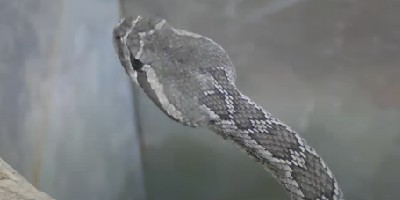 Southern Pacific Rattlesnake:
Several species and subspecies of rattlers reside throughout California, and the Southern Pacific is one of them, obviously. Highly venomous, these snakes are usually around three feet in length, though they can grow longer. Normally brown-hued in coloration with a darker pattern, these rattlers are largely nocturnal unless it’s cooler outside. They feed primarily on rodents since mammals are warm-blooded and thus easier for them to notice with their heat-sensing organs. Adult California ground squirrels are an exception, as they are immune to rattlesnake venom and tend to get upset when a snake tries to eat them. Rattlers will also eat other reptiles and birds. As with any highly venomous snake, caution is recommended if encountered in the wild. Though they may give warning of their presence if aggravated, many rattlers will bite if agitated.
Southern Pacific Rattlesnake:
Several species and subspecies of rattlers reside throughout California, and the Southern Pacific is one of them, obviously. Highly venomous, these snakes are usually around three feet in length, though they can grow longer. Normally brown-hued in coloration with a darker pattern, these rattlers are largely nocturnal unless it’s cooler outside. They feed primarily on rodents since mammals are warm-blooded and thus easier for them to notice with their heat-sensing organs. Adult California ground squirrels are an exception, as they are immune to rattlesnake venom and tend to get upset when a snake tries to eat them. Rattlers will also eat other reptiles and birds. As with any highly venomous snake, caution is recommended if encountered in the wild. Though they may give warning of their presence if aggravated, many rattlers will bite if agitated.
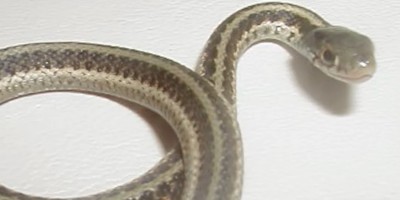 South Coast Garter:
This pretty red, yellow, and black snake is one of many garter snake subspecies and species residing across California, and indeed the United States. Like most garters, the colors are in lines along their bodies, which for this species is usually three feet in length or thereabouts. Most garters feed on a widely varied diet, and these coastal variants are no exception. They eat fish, birds, amphibians, small reptiles, and leeches. Coastal garters are also one of the few predators that can eat Pacific Newts, which are normally highly poisonous. This snake is considered threatened due to its narrow habitat range.
South Coast Garter:
This pretty red, yellow, and black snake is one of many garter snake subspecies and species residing across California, and indeed the United States. Like most garters, the colors are in lines along their bodies, which for this species is usually three feet in length or thereabouts. Most garters feed on a widely varied diet, and these coastal variants are no exception. They eat fish, birds, amphibians, small reptiles, and leeches. Coastal garters are also one of the few predators that can eat Pacific Newts, which are normally highly poisonous. This snake is considered threatened due to its narrow habitat range.
If you're unsure, you can email me a photo of the snake at info@sanbernardinosnakes.com and I will email you back with the snake's species. If you found a snake skin, read my Found a Skin? page, and you can email me a photo of the skin, and I'll identify the snake for you. If you need professional San Bernardino snake removal help, click my Get Help page, or see the below website sponsor I found, who provides that service.
Remember, the term is not poisonous snakes of San Bernardino, it's venomous snakes of San Bernardino. Poison is generally something you eat, and venom is injected into you. That said, dangerous snakes are very rare in San Bernardino. The few venomous snakes of San Bernardino County are rarely seen. But they are commonly misidentified, so learn about all the snake species of San Bernardino in order to correctly identify them. These snakes are usually also found in the surrounding towns of Fontana, Rancho Cucamonga, Ontario, Redlands, Victorville, Rialto, Yucaipa, Hesperia, Barstow, Highland, Upland, Colton, Chino, Loma Linda, Chino Hills, Apple Valley, Big Bear Lake, Yucca Valley, Adelanto, Twentynine Palms, Lake Arrowhead,n Joshua Tree, Montclair, Crestline, Muscoy, Bloomington, Big Bear, Grand Terrace, Needles, Running Springs, Lucerne Valley, Lytle Creek, Pinon Hills, Mentone, Helendale, Phelan, Wrightwood, Morongo Valley, Spring Valley Lake, Oak Hills, Angelus Oaks, Daggett, Newberry Springs, Forest Falls, Amboy, Hinkley, Pioneerto, and the surrounding areas.
Read our article about:
Do snakes jump?
sanbernardinosnakes.com domain and hosting costs made possible by the generous support of this sponsor:
